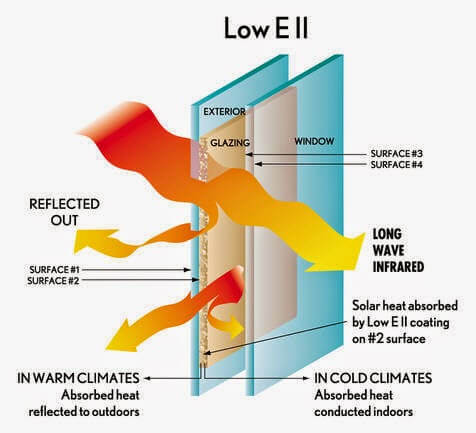It’s now time to ask some hard questions about how your windows are “holding down the fort.”
Are your windows working hard to help you save on energy costs both day and night? It’s actually impossible for most windows to do this if they lack one very important type of window technology.
When getting new windows, it’s easy to assume that a tight fit with quality construction is everything. While that is important, it’s not the whole story. That’s because a window design can only be as efficient as the glass used allows it to be.
That’s where Low-E windows come into the picture.
While all homeowners need to know about Low-E windows, it’s especially important to know about them if you live in a hot climate. These windows can also be game changers if your home is positioned in a way that creates tons of sun exposure.
So, What Exactly Are Low E Windows?
Low-E windows are made with low-emissivity glass that is capable of minimizing the amounts of infrared and ultraviolet (UV) light entering your home. While Low-E windows look the same as ordinary windows, they have a “microscopically thin” coating that helps to retain consistent temperatures inside your home.
The big deal about Low-E windows is that they reduce your home’s UV and infrared exposure without comprising the amount of visible “good” light that’s allowed to pass through your windows. That means you’re getting a bright, sunny house without losing energy efficiency.
What are Low E windows good for? Take a look at the benefits of Low-E windows.
Improved Energy Efficiency at Your Home

The top reason to choose Low-E windows is that you’re going to save on energy costs. This technology allows your home to retain more of that cold air that your air conditioner is pumping in.
In addition to creating a more comfortable and consistent indoor temperature, the improved insulation delivered by Low-E windows is going to stop your air conditioner from having to work so hard to achieve ideal temperatures. This can save you money when it comes to repair and replacement costs for your HVAC system.
There’s a Special Low-E Treatment for Hot Climates
Texans can rejoice over the fact that there’s actually a specific window treatment for windows designed to make them even more efficient in cold-to-hot climates. This treatment is called a “solar control” Low-E coating (soft coat).
The soft coat offers superior UV protection when compared to the cold-weather option. It also reflects both warm and cold air back into a room instead of allowing leakage.
When Low-E glass is helping to cool a home, it’s actually reflecting solar thermal energy from outside the home. Yes, a simple coating can actually do that!
If you choose the “soft coat” option, it’s necessary to enclose the protective coating inside a window that’s double pane to ensure that there’s enough protection.
Low-E Window Treatments Are Essentially Transparent

Low-E glass looks just like any clear standard glass that you’d use with single or double pane windows. The microscopic coating that’s applied is completely transparent. That means you’re not dealing with cloudy or opaque views just because you’re getting better insulation via a glass coating.
Less Glare Than Other Windows
Low-E glass actually reduces glare caused by natural light when compared to ordinary, uncoated glass.
UV Protection
Low-E glass stops almost all UV radiation from entering your home! Why does this matter? First, UV light actually bleaches cabinets, carpets, furniture and more. Second, pets and people can enjoy some window gazing without worrying about UV exposure.
Of course, Low-E coatings are able to reject those UV wavelengths that cause problems without cutting down on any visible light waves that are trying to pass through your windows to brighten things up!
Easy Installation With No Special Steps
The fact that the technology that creates Low-E windows is an ultra-thin coating means that upgrading to this ultra-efficient option isn’t any more complicated than having regular windows installed.
The Low-E coating is applied when your glass is still raw prior to installation. Your window installers won’t have to perform any special installation techniques using special tools or add-on features because the protection is built right into your glass!
Durability
There’s an added advantage to Low-E windows that goes beyond energy savings. The coating that’s “surface sealed” within your window unit is extremely durable. That means that your windows are going to retain top performance and beauty year after year without much need for maintenance.
Low-E Coatings Are Compatible With Other Features
This last perk is a big deal if you’re interested in ordering specialty windows. Low-E coatings are completely compatible with all of the other features you’d want to add to your window. It doesn’t prohibit you from adding security features, noise-proofing or any special cleaning technology to your windows.
What’s the Next Step?
If you’re about to replace windows in your home, it’s time to book a window installation estimate to see how much various window options cost. While you’re getting an estimate, be sure to inquire about the cost to upgrade to Low-E windows.
Yes, adding Low-E windows to your home is going to be more expensive than adding uncoated windows. However, that initial price increase only reflects the one-time price of choosing high-efficiency windows.
The cost savings offered by Low-E windows create a situation where choosing uncoated windows could actually cost you more money over time.
Final Thoughts on Low-E Windows
The problem with window coverings is that they force you to darken a room for the sake of retaining the temperature. In addition to robbing you of your views, this can make a room seem small and depressing. Low-E windows provide what effectively operates like an “invisible” window shade that offers full transparency!
Low-E windows make it possible to keep out harmful light while letting “good” light shine through your windows. The incredible insulation offered by this option makes it easy to reduce cooling bills.
As eco-friendly building practices grow, it’s very likely that Low-E windows will soon become the “standard” for new constructions. People who own existing homes can make their properties more competitive by installing Low-E windows when it’s time to make window updates. This allows homeowners to begin enjoying energy savings today while being more optimistic about home values down the line.
